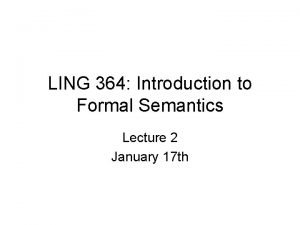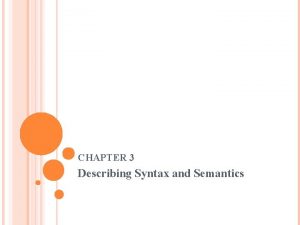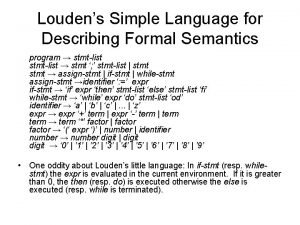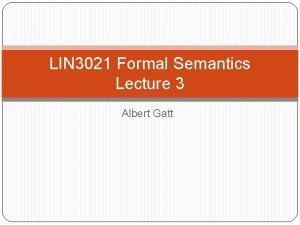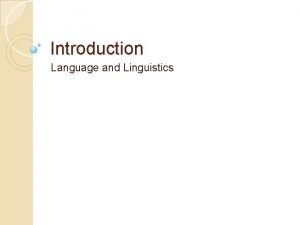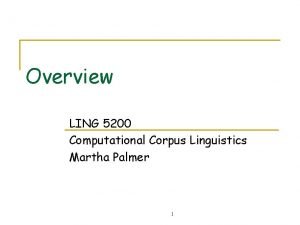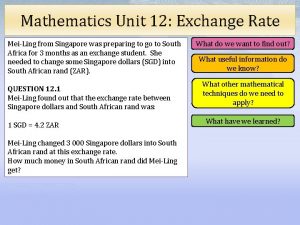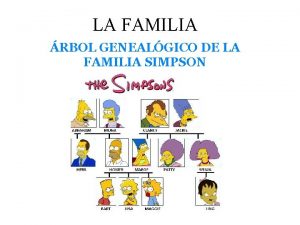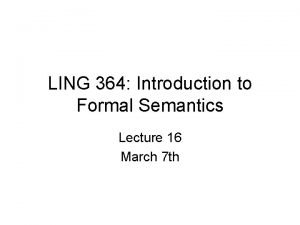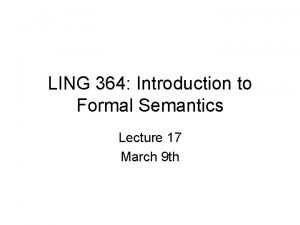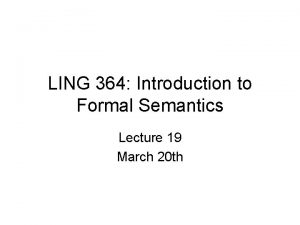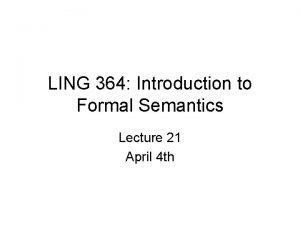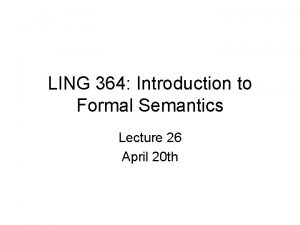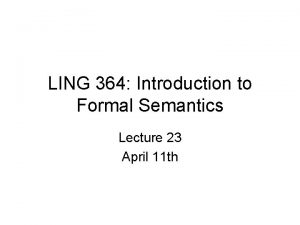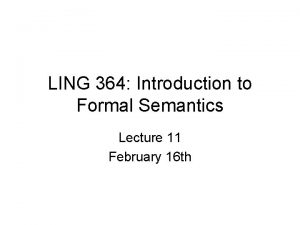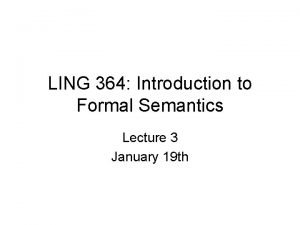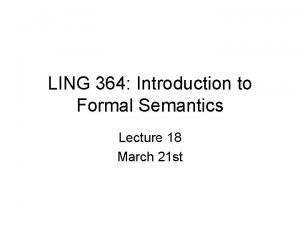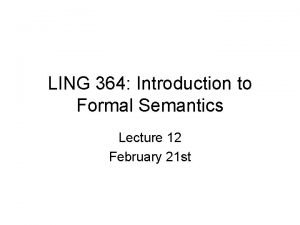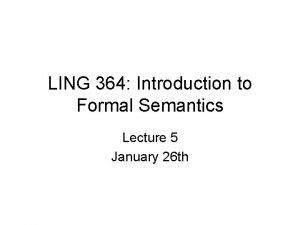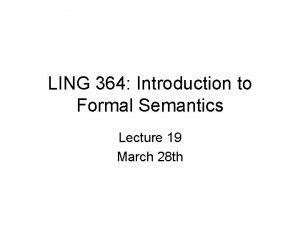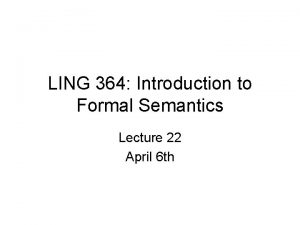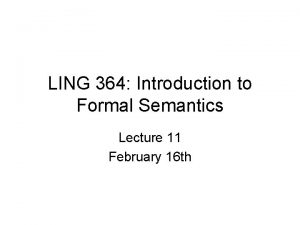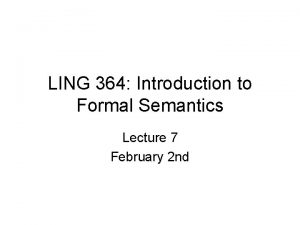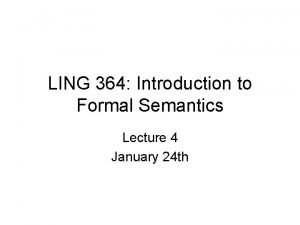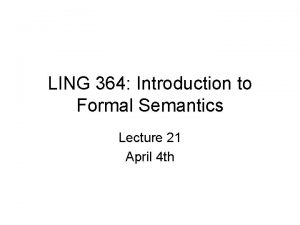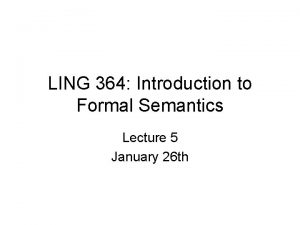LING 364 Introduction to Formal Semantics Lecture 25





















- Slides: 21

LING 364: Introduction to Formal Semantics Lecture 25 April 18 th

Administrivia • Homework 5 – graded and returned

Administrivia • Today – review homework 5 – also new handout • Chapters 7 and 8 • we’ll begin talking about tense

Homework 5 Review • Exercise 1: Truth Tables and Prolog P ⇒ Q P v Q T T T • Question A: Using F T T F T F F T T F • ? - implies(P, Q, R 1), or(P, Q, R 2), + R 1 = R 2. • for what values of P and Q are P⇒Q and Pv. Q incompatible? ? - implies(P, Q, R 1), or(P, Q, R 2), + R 1=R 2. P = true, Q = false, R 1 = false, R 2 = true ? ; P = false, Q = false, R 1 = true, R 2 = false ? ; no R 1 Let P⇒Q = R 1 implies(P, Q, R 1) R 2 Pv. Q = R 2 or(P, Q, R 2) compare values

Homework 5 Review • Exercise 1: Truth Tables and Prolog • Question B • Define truth table and/3 in Prolog P ∧ Q T T T F F F T F F Result % and(P, Q, Result) and(true, true). and(true, false). and(false, false).

Homework 5 Review • Exercise 1: Truth Tables and Prolog • Question C • Show that • ¬(P∨Q) = ¬P∧¬Q • (De Morgan’s Rule) P v Q P ¬P Q ¬Q T T F T F F T T F F F T T T F F T R 1 ? - or(P, Q, R 1), neg(R 1, NR 1), neg(P, NP), neg(Q, NQ), and(NP, NQ, R 2), + NR 1=R 2. No ¬P ∧ ¬Q R 1 ¬R 1 F F F T F T T T F T F F T R 2

Homework 5 Review • Exercise 1: Truth Tables and Prolog • Question D – Show that – ¬(P∧Q) = ¬P∨¬Q – (another side of De Morgan’s Rule) • Question C was for • ¬(P∨Q) = ¬P∧¬Q ? - and(P, Q, R 1), neg(R 1, NR 1), neg(P, NP), neg(Q, NQ), or(NP, NQ, R 2), + NR 1=R 2. no

Homework 5 Review • Exercise 2: Universal • Quantification and Sets • Assume meaning grammar: saturate 1(P, X) : - arg(1, P, X). saturate 2(P, X) : - arg(2, P, X). subset([], _). subset([X|L 1], L 2) : - member(X, L 2), subset(L 1, L 2). member(X, [X|_]). member(X, [_|L]) : - member(X, L). predicate 1((findall(X, P, _), P) : saturate 1(P, X). predicate 2((_, (findall(X, P, _)), P) : saturate 1(P, X). s(M) --> qnp(M), vp(P), {predicate 2(M, P)}. n(woman(_)) --> [woman]. vp(M) --> v(M), np(X), {saturate 2(M, X)}. v(likes(_X, _Y)) --> [likes]. np(ice_cream) --> [ice, cream]. qnp(M) --> q(M), n(P), {predicate 1(M, P)}. q((findall(_X, _P 1, L 1), findall(_Y, _P 2, L 2), subset(L 1, L 2))) --> [every]. every has semantics {X: P 1(X)} ⊆ {Y: P 2(Y)} every woman likes ice cream {X: woman(X)} ⊆ {Y: likes(Y, ice_cream)} –? - s(M, [every, woman, likes, ice, cream], []). –M = findall(A, woman(A), B), findall(C, likes(C, ice_cream), D), subset(B, D)

Homework 5 Review • Exercise 2: Universal Simple way using Generalized Quantifiers) • Quantification and Sets (not s(P) --> namenp(X), vp(P), {saturate 1(P, X)}. namenp(john) --> [john]. • Questions A and B – John likes ice cream note: very different from s(M) --> qnp(M), vp(P), {predicate 2(M, P)}. ? - s(M, [john, likes, ice, cream], []). M = likes(john, ice_cream) ? - s(M, [john, likes, ice, cream], []), call(M). M = likes(john, ice_cream) database woman(mary). woman(jill). likes(john, ice_cream). likes(mary, ice_cream). likes(jill, ice_cream).

Homework 5 Review • Exercise 2: Universal Quantification and Sets • Question C – (names as Generalized Quantifiers) – Every woman and John likes ice cream – ({X: woman(X)} ∪{X: john(X)}) ⊆ {Y: likes(Y, ice_cream)} – John and every woman likes ice cream Treat John just like every: s(M) --> qnp(M), namenp(M), vp(P), {predicate 2(M, P)}. qnp(M) namenp((findall(X, P, L 1), findall(_Y, _P 2, L 2), subset(L 1, L 2))) --> q(M), n(P), {predicate 1(M, P)}. --> name(P), q((findall(_X, _P 1, L 1), findall(_Y, _P 2, L 2), subset(L 1, L 2))) {saturate 1(P, X)}. --> [every]. n(woman(_)) name(john(_))--> -->[woman]. [john]. database: john(john) ? - s(M, [john, likes, ice, cream], []). M = findall(A, john(A), B), findall(C, likes(C, ice_cream), D), subset(B, D))

Homework 5 Review slide is animated • Exercise 2: Universal Quantification and Sets • Question C – John and every woman likes ice cream – ({X: john(X)} ∪{Y: woman(Y)}) ⊆ {Z: likes(Z, ice_cream)} findall P 1 findall P 2 findall union subset Define conjnp: s(M) --> conjnp(M), vp(P), {predicate 2(M, P)}. conjnp(((findall(X, P 1, L 1), findall(Y, P 2, L 2), union(L 1, L 2, L 3)), findall(_, _, L 4), subset conjnp(__________) --> namenp(M 1), [and], qnp(M 2). conjnp(((findall(X, P 1, L 1), findall(Y, P 2, L 2), union(L 1, L 2, L 3)), findall(_, _, L 4), subset (L 3, L 4))) --> namenp(M 1), [and], {predicate 1(M 1, P 1), predicate 1(M 2, P 2), namenp(M 1), [and], qnp(M 2). {predicate 1(M 1, P 1)}. qnp(M 2), {predicate 1(M 1, P 1), predicate 1(M 2, P 2)}. saturate 1(P 1, X), saturate 1(P 2, Y)}. M 1 ? - =s(M, [john, and, every, woman, likes, ice, cream], []). findall(_A, john(_A), _B), findall(_C, likes(_C, ice_cream), _D), subset(_B, _D) M= = findall(_A, woman(_A), _B), findall(_C, likes(_C, ice_cream), _D), subset(_B, _D) (findall(A, john(A), B), findall(C, woman(C), D), union(B, D, E)), M 2 findall(F, likes(F, ice_cream), G), subset(E, G)

Homework 5 Review • Exercise 3: Other Generalized Quantifiers • Question A no: {X: P 1(X)} ∩ {Y: P 2(Y)} = ∅ – No woman likes ice cream qnp(M) --> q(M), n(P), {predicate 1(M, P)}. q((findall(_X, _P 1, L 1), findall(_Y, _P 2, L 2), subset(L 1, L 2))) --> [every]. q((findall(_X, _P 1, L 1), findall(_Y, _P 2, L 2), intersect(L 1, L 2, []))) --> [no]. ? - s(M, [no, woman, likes, ice, cream], []). M = findall(_A, woman(_A), _B), findall(_C, likes(_C, ice_cream), _D), intersect(_B, _D, []) ? - s(M, [no, woman, likes, ice, cream], []), call(M). no

Homework 5 Review • Exercise 3: Other Generalized Quantifiers • Question A some: {X: P 1(X)} ∩ {Y: P 2(Y)} ≠ ∅ – Some women like ice cream – *Some woman likes ice cream (plural agreement) qnp(M) --> q(M), n(P), {predicate 1(M, P)}. q((findall(_X, _P 1, L 1), findall(_Y, _P 2, L 2), subset(L 1, L 2))) --> [every]. q((findall(_X, _P 1, L 1), findall(_Y, _P 2, L 2), intersect(L 1, L 2, L 3), +L 3=[])) --> [some]. don’t have to implement agreement in this exercise, you could just add: n(woman(_)) --> [women]. v(likes(_X, _Y)) --> [like].

Homework 5 Review • Exercise 3: Other Generalized Quantifiers • Question A some: {X: P 1(X)} ∩ {Y: P 2(Y)} ≠ ∅ – Some women like ice cream – *Some woman likes ice cream (plural agreement) qnp(M) --> q(M), n(P), {predicate 1(M, P)}. q((findall(_X, _P 1, L 1), findall(_Y, _P 2, L 2), subset(L 1, L 2))) --> [every]. q((findall(_X, _P 1, L 1), findall(_Y, _P 2, L 2), intersect(L 1, L 2, L 3), +L 3=[])) --> [some]. ? - s(M, [some, women, like, ice, cream], []), call(M). M= findall(_A, woman(_A), [mary, jill]), findall(_B, likes(_B, ice_cream), [john, mary, jill]), i ntersect([mary, jill], [john, mary, jill], [mary, jill]), +[mary, jill]=[]

• Chapter 8: Tense, Aspect and Modality

Tense • Formal tools for dealing with the semantics of tense (Reichenbach): – use the notion of an event – relate • utterance or speech time (S), • event time (E) and • reference (R) aka topic time (T) – S, E and T are time intervals: R yesterday 0: 00 • think of them as time lines • equivalently, infinite sets containing points of time – examples of relations between intervals: • precedence (<), inclusion (⊆) 23: 59 S 16: 07

�Past Tense • Example: – (16) Last month, I went for a hike – S = utterance time – E = time of hike • What can we infer about event and utterance times? – E is within the month previous to the month of S – (Note: E was completed last month) • Tense (went) – past tense is appropriate since E < S • Reference/Topic time? –may not seem directly applicable here –T = last_month(S) –think of last_month as a function that given utterance time S –computes a (time) interval –name that interval T

�Past Tense • Example: – (16) Last month, I went for a hike • What can we infer? – – T = reference or topic time T = last_month(S) E ⊆T E is a (time) interval, wholly contained within or equal to T • Tense (went) – past tense is appropriate when – T < S, E ⊆T

�Past Tense • Example: – (17) Yesterday, Noah had a rash • What can we infer? – – – – • T = yesterday(S) “yesterday” is relative to utterance time (S) E = interval in which Noah is in a state of having a rash E may have begun before T E may extend beyond T expression reminiscent of the E may have been wholly contained within T corresponding expression for E⋂T≠∅ Tense (had) – appropriate since T < S, E ⋂ T ≠ ∅ the generalized quantifier some

Simple Present Tense • In English (18 a) Mary runs (simple present) has more of a habitual reading – does not imply (18 b) Mary is running (present progressive) – T = S, run(mary) true @ T = “at time T” • i. e. Mary is running right now at utterance time – (cf. past: T < S) • • However, the simple present works when we’re talking about “states” Example: (has) – (18 c) Noah has a rash – rash(noah) true @ T, T=S (simple present) – i. e. Noah has the property of having a rash right now at utterance time English simple present tense: T=S, E has a stative interpretation, E ⋂ T ≠ ∅

Simple Present Tense • Some exceptions to the stative interpretation idea • Historical Present – present tense used to describe past events – Example: • (19 a) This guy comes up to me, and he says, “give me your wallet” • cf. This guy came up to me, and he said. . . • Real-time Reporting – describe events concurrent with utterance time – Example: • (19 b) She kicks the ball, and – it’s a goal! • cf. She is kicking the ball
 1618 lz
1618 lz Round 246 to the nearest hundred
Round 246 to the nearest hundred Bleach 364
Bleach 364 Tm 11-6665-364-12
Tm 11-6665-364-12 Compare procedural semantics and declarative semantics.
Compare procedural semantics and declarative semantics. 01:640:244 lecture notes - lecture 15: plat, idah, farad
01:640:244 lecture notes - lecture 15: plat, idah, farad Formal semantics examples
Formal semantics examples General problem of describing syntax and semantics in ppl
General problem of describing syntax and semantics in ppl Loudens
Loudens Formal semantics
Formal semantics What is formal semantics
What is formal semantics Jin ling cigarettes
Jin ling cigarettes Qüvvədə qazanc
Qüvvədə qazanc Ling
Ling Erin ling
Erin ling Ling oa
Ling oa Mei-ling from singapore was preparing
Mei-ling from singapore was preparing Como se llama el papa de marge simpson
Como se llama el papa de marge simpson Dr ng li ling
Dr ng li ling Nien-ling wacker
Nien-ling wacker 施玲玲
施玲玲 Ling simpson
Ling simpson






